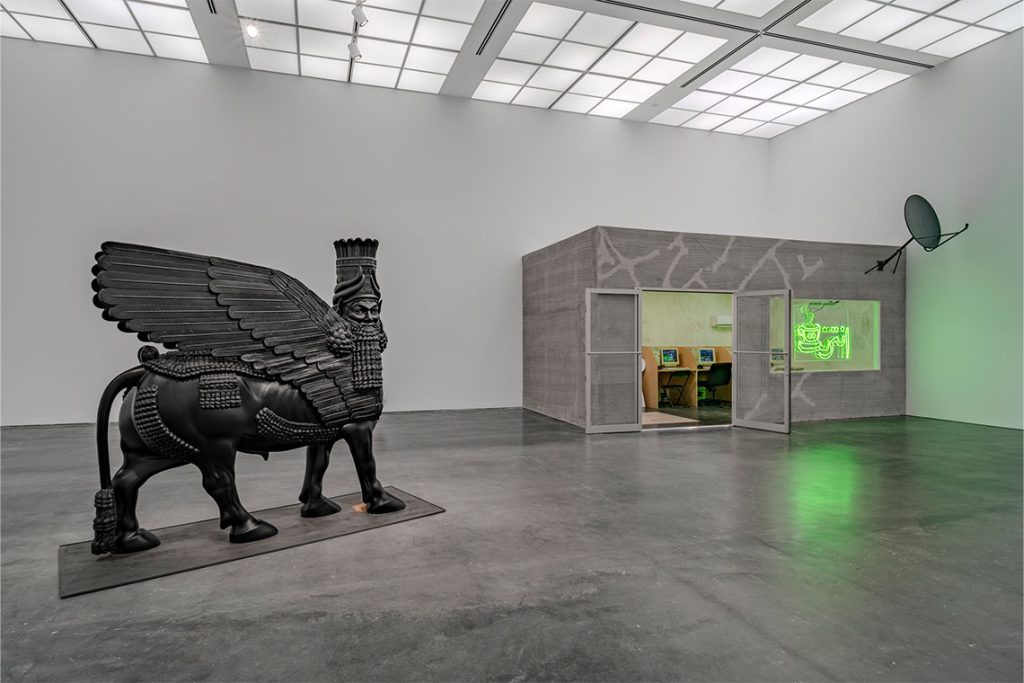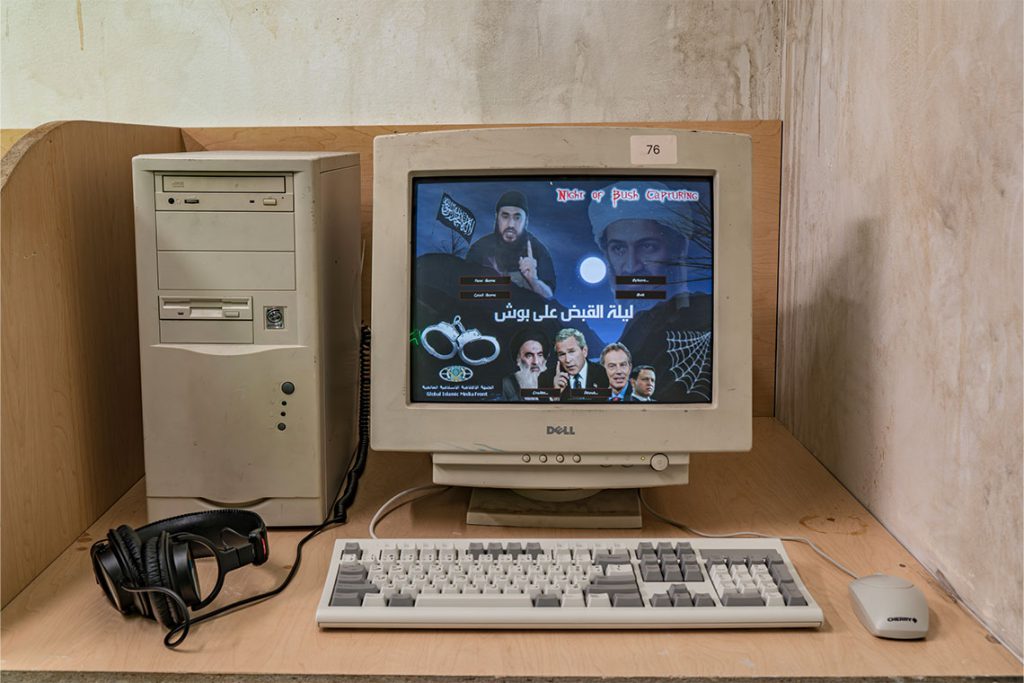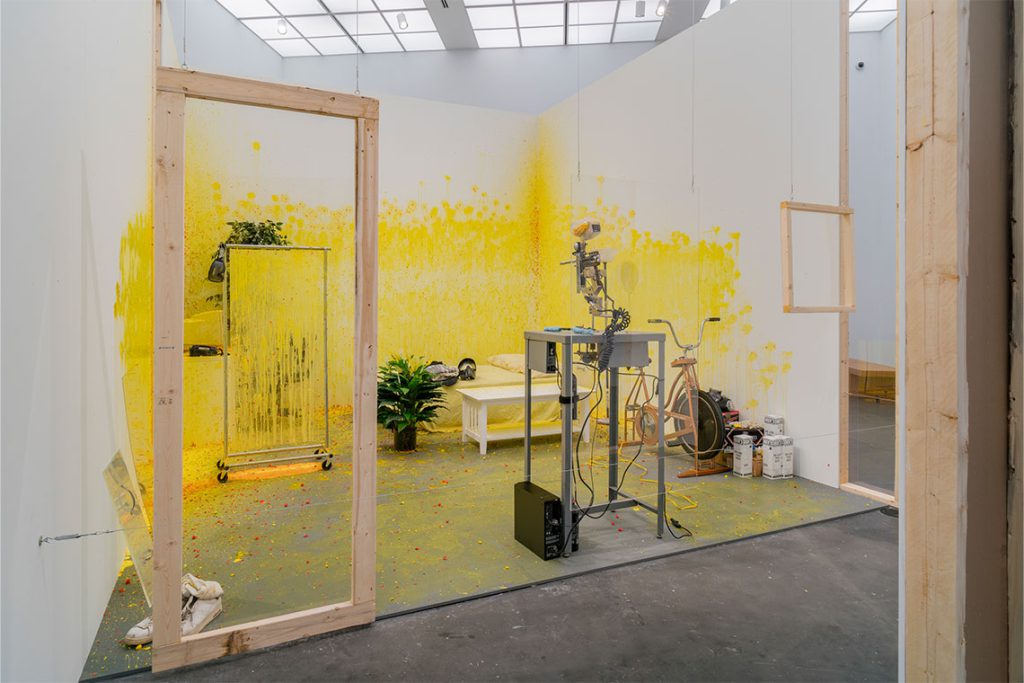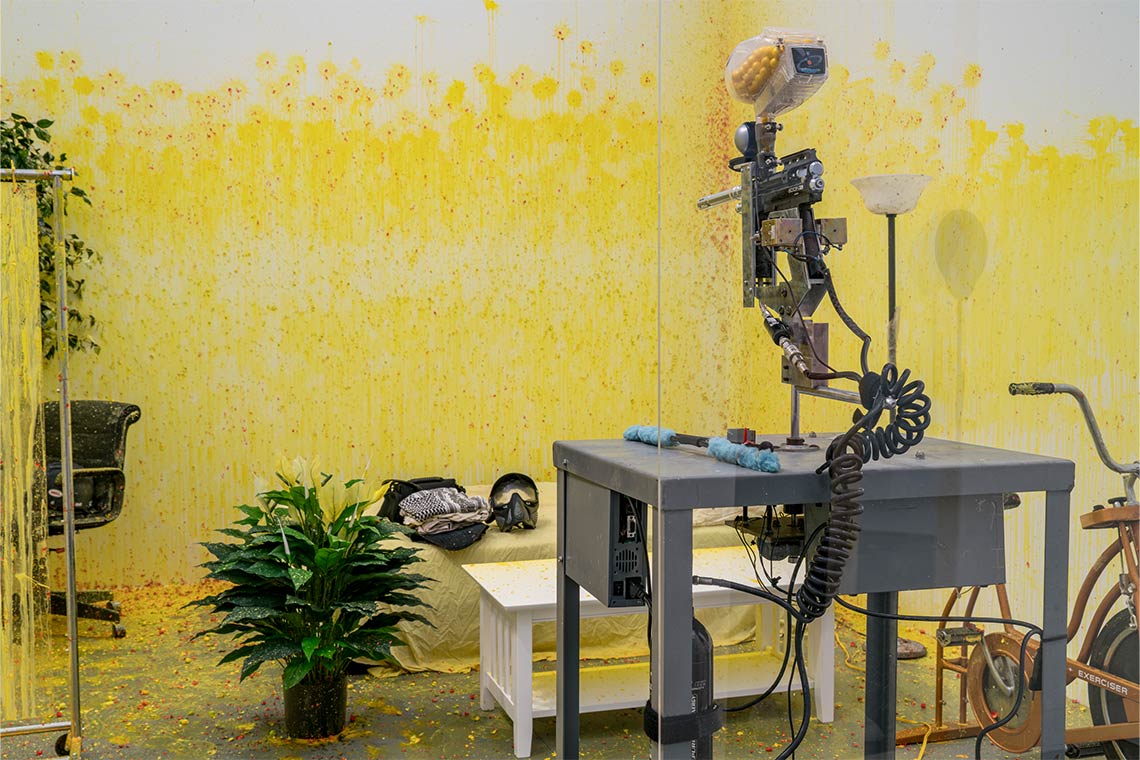Wafaa Bilal’s current survey exhibition, Indulge Me at MCA Chicago, prompts uncomfortable awareness, empathy and understanding of the world beyond our comfort zones.
Back in 2007, in a performance called Domestic Tension, Wafaa Bilal was shot with paintballs 65,000 times over a month by a gun connected to the internet. Anonymous IP addresses from 128 countries tuned in to chat, witness, shoot or sometimes prevent him from being hit, and overall, the 24-hour live-streaming interactive website received 80 million hits.
Bilal’s current survey show Indulge Me at MCA Chicago, curated by Bana Kattan, features a replica of that performance. It is presented in a reproduction of the artist’s self-imposed confinement space, originally at Chicago’s FlatFile Gallery, which is stained with yellow paint and littered with paintball casings. The gun is mounted on a computer, filled with paint pellets, ready and aimed. For the performance, strangers could log on and shoot Bilal, transforming a virtual experience into real-world consequences. For the duration of the work the artist also recorded a video blog detailing his thoughts and emotions while living under constant fire from faceless hostility.
Domestic Tension was partially a reaction to the death of Bilal’s brother, Haji, who was killed by a US missile strike at a checkpoint in Iraq in 2004. “I contemplated how an artist could respond to such tragedy and engage people in a dialogue about loss,” Bilal explained. The resulting performance and documentation became a crucial commentary on the gamification of violence and the disconnect of remote warfare, in which military attacks inflict casualties among people thousands of miles away.

Photography by Bob (Robert Chase Heishman)
The piece also prompted further questions around privacy, the surveillance imposed upon those living under Saddam Hussein’s regime and the impact of war and physical confinement as a result of bombardments. The year of the work’s conception also saw the highest number of American soldiers killed in Iraq and the ramping up of the civil war between the Sunni and Shia factions due to the US invasion. For Bilal, Domestic Tension was a turning point in terms of interacting with current affairs: “It was an important moment in art history because the boundaries were breaking between the virtual and the physical [realms],” recalls Bilal. “It was important to give people the platform to interact with each other about political matters, but what really mattered in the moment was the anonymity of the internet. It allowed people to act on their impulses and enter the artwork from their homes or offices, in their own comfort zones… I didn’t want people to think this is an artwork, in fact. It was creating a conflict zone within the comfort zone of the United States.”
Much of Bilal’s practice combines art, performance and technology to challenge structures of oppression and to explore the concept – referenced throughout the exhibition – of ‘cultural cannibalism’, whereby the culture of a community is dismantled, destroyed or consumed by another group or aggressor. The artist uses his body as a vessel and often implicates the audience through their participation or witnessing of the work, delving into what it means to elicit empathy, reflection and connection. The notion of complicity is exemplified further in 3rdi (2010–11), for which the artist implanted a camera in the back of his head for a year. Images were livestreamed to a website where Bilal’s camera would objectively take a picture every minute and transmit it online, capturing everything behind him and thereby sharing stories of moments or places that otherwise might have gone unnoticed. The images were presented to be consumed. “As Arabs, as Muslims, we are being watched all the time, so I am challenging the system by unifying the apparatus with my body. I become the apparatus and with every [image] you’re watching me and my private life.” expressed Bilal. Instead, he was the one watching everyone else. The installation also emphasises the urgent nature of fleeting moments, as the images were presented to synchronise with the date and time that visitors accessed the space. Each image was shown only for that minute, never to be repeated again.

Photography by Bob (Robert Chase Heishman)
Indulge Me also includes another of Bilal’s iconic works, Virtual Jihadi (2008). The year 2003 saw the release of the video game Quest for Saddam, in which players fight Iraqi soldiers (villainously stereotyped) with the end goal of killing Saddam Hussein. Three years later, and in response, an Al Qaeda propaganda organisation created an online version posed as the hunt for George W Bush, entitled The Night of Bush Capturing. In Bilal’s Virtual Jihadi, the artist inserts himself into the Al Qaeda version as a suicide-bomber, driven to join the group after being radicalised by his brother’s death. His presence serves as a commentary on the vulnerability of Iraqi civilians and the impacts of war, as well as the recruitment efforts of groups such as Al Qaeda, the susceptibility of frustrated Iraqi citizens and harmful stereotypes based on hate and disseminated via the media. In a similar vein to Domestic Tension, the video game sheds light on the general American disconnect from the suffering of those in conflict zones, driven by the ability to tune in, tune out, log on and log off from what seems to be a distant, or virtual, reality far removed from the comfort zone of the USA.
However, Bilal’s version of the video game was originally deemed offensive and was removed the day after it opened at the Rensselaer Polytechnic Institute in Troy, New York, where he was an artist in residence. It was then offered space at The Sanctuary for Independent Media. Protests ensued and within 24 hours the city’s code enforcement authority shut down the building for health and safety violations. Apparently the doors were not wide enough. For the MCA iteration, Virtual Jihadi is presented in a faux internet café, neon lights glaring on the outside and a broken-down PC on one of the desks. Greeted by a cardboard cut-out of Bilal in his “skin”, the playable game is loaded and ready to go for audiences to interact with. “I am thankful to MCA, as we have made the doors really wide so no one can complain,” laughs Bilal.

Photography by Bob (Robert Chase Heishman)
Another standout at the exhibition is the ongoing project, In a Grain of Wheat, in which the artist highlights the destruction of culture in the face of terrorism, invasion and war, posing questions of cultural preservation and legacy. In this work he archives the 3000-year-old sculpture, the Winged Bull of Nineveh, by coding data of 3D scans inside the DNA of Iraqi wheat seeds. The original Assyrian monument was destroyed by ISIS in 2015, but Bilal worked with the Metropolitan Museum in New York to create 3D scans of a sister version of the Winged Bull in an effort to protect Iraqi heritage through a collaborative combination of art, science and nature. “When you take the grain of wheat, you can find our cultural stories embedded in the DNA,” the artist shares. “You could grow it, reverse engineer it, and you get our ancestral knowledge.” His website also states that “In a Grain of Wheat will become a ‘gateway’ project for the development of a collaborative seed bank dedicated to Iraq’s material culture. This is an ambitious vision, but one that in theory is made feasible by the immense storage capacity of biological material – as well as the fundamentally cooperative nature of humankind, which functions as part of the work, turning it into a social as well as bio-digital sculpture.”
In the survey exhibition, Wafaa Bilal’s works, political but also very human, pose new questions around freedoms in continued relevancy under new contexts and asked what are we consuming as culture, saving, sharing or destroying? Are we engaging or becoming numb to others’ pain and pleasure? Where do we go from here? Who is being watched and where might be a comfort zone now? Throughout the exhibited works, the artist uses his body and performance to connect and promote empathy, as he sums up to Canvas: “In order to have the audience to not necessarily understand but to empathise and bring them to action, I need to speak to the body, not only to the mind, and that is why performance is so important to employ.”



